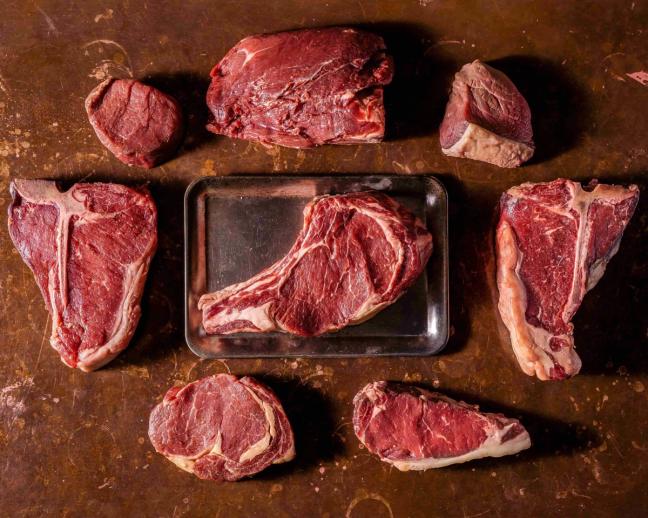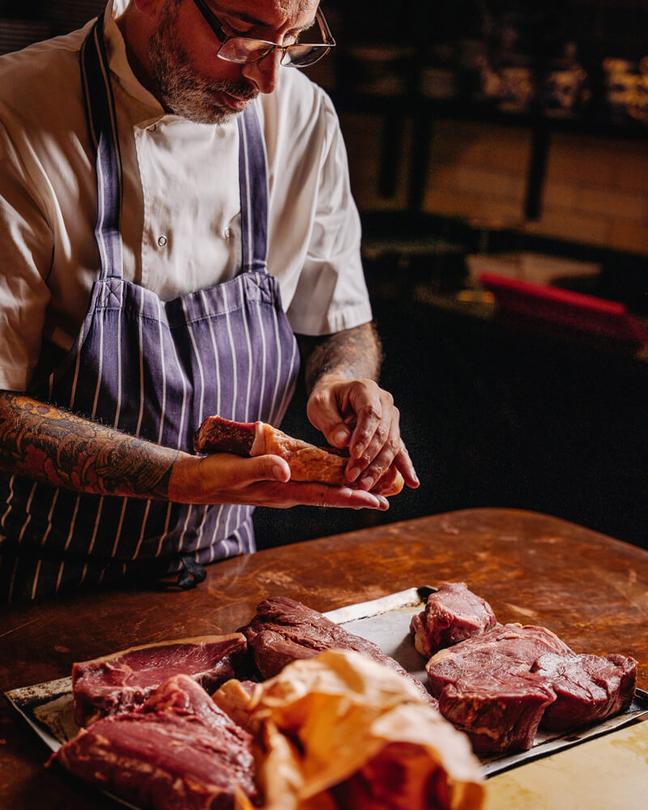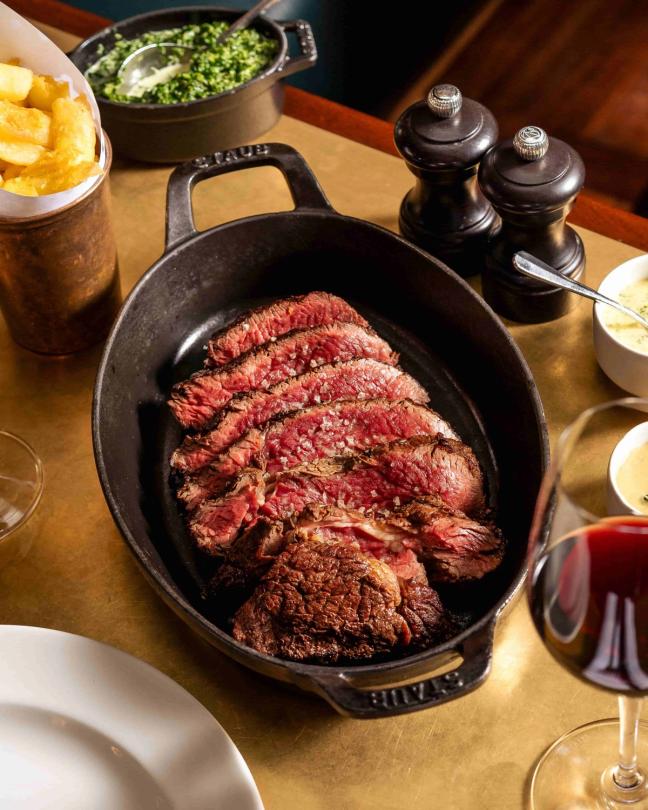How to cook a perfect steak
The cut. The seasoning. The rest time. Here are the rules to follow...
How do you cook a perfect steak? That’s the meatiest question of all. And the stakes, if you’ll excuse the pun, couldn’t be higher. Just ask the French philosopher Roland Barthes: ‘It is the heart of meat, it is meat in its pure state’.
No wonder, then, that seemingly every single chef on the planet has put forth their own favoured method at one time or another. In an effort to settle the debate once and for all, and to show how it’s done right, we asked Will Beckett and Huw Gott, the co-founders of Hawksmoor, the UK’s most esteemed meat wonderland, to reveal their tricks that will fire up your grilling prowess.
1. Buy good meat
This is the key. But it can be easier said than done – our advice is to find a good butcher and ask lots of questions*
2. Buy big
The aim is to get a good char on the outside while keeping the meat juicy and tender inside; this is very difficult with a thin piece of meat. Ideally, each steak should be at least 300g and 4cm thick. Or buy bigger and share a steak between a couple of people.

All images courtesy of Hawksmoor
3. Regulate the temperature
Take the meat out of the fridge at least an hour before you cook it, to bring it up to room temperature.
4. Fire up the barbecue. Or, if it’s raining, dig out a heavy cast-iron griddle pan
If you’re using a barbecue, we recommend lumpwood charcoal from sustainable sources, and make sure you use eco-friendly non-impregnated firelighters to avoid any fuel tainting the flavour of the meat. There are three ingredients in a steak: beef, charcoal and salt. Getting all three right is crucial – there’s no point buying a beautiful piece of beef and using lighter-fuel-impregnated briquettes from the local petrol station.
5. Get the barbecue or pan really, really hot
You’re looking for white-hot coals on the barbecue, which will take about an hour from lighting. The grill pan needs 5 minutes over a high heat. It should be painful to hold your hand anywhere near the heat source, which is why our grill chefs have to drink so much water.
6. If you’re inside, open the window
There will be lots of smoke.

7. If your steak is wet, pat it dry with kitchen paper
Otherwise it will struggle to form a decent crust and can pick up some unpleasant boiled-meat flavours. And then, at the last minute, season the meat well with Maldon sea salt. You will need to use more than you probably think sensible, but it will help build up a delicious salty crust. Pick up a handful of salt in your right hand, and your steak in your left. Assuming your steak is the right size (at least 300g and 4cm thick), throw the salt at it and whatever sticks is the right amount. Move the steak around so every surface is coated. If you’re cooking a large sharing steak, you’ll need to pat the salt in a little to give you more (yes, more). And if you’ve ended up with skinny minute steaks, use a fair bit less.
8. Don’t use any oil on the meat or in the pan
If the grill is hot enough, the meat won’t stick. As well as being unnecessary, oil tends to add a hint of flavour that doesn’t sit well with good beef. If you’re really worried, you can cut a small piece of fat off your steak (or ask your butcher for a piece) and rub it over the grill with a pair of tongs.
9. Stick the steak on
Leave it for a couple of moments to start building up a crust, then flip. Carry on turning every couple of minutes until it’s the way you like it, and don’t forget to sear the edges. If the heat is as fierce as our charcoal grill at Hawksmoor, you may need to move it more regularly to avoid burning – our grill chefs say every 5 seconds. Don’t overcrowd the grill or the pan – make sure there’s plenty of space between the steaks.

10. Check if your steak is cooked
You can use touch** which our grill chefs do, or you can use a probe (which our grill chefs also do) to make sure every steak is perfect. Cooking temperatures are subjective and perceptions even vary from country to country. These are our recommended temperatures, and are a touch more cooked than they might be in France or Spain. The internal temperature should be at the bottom end of each range at the end of cooking and towards the top end once rested.
— medium-rare 55°C to 60°C
— medium 60°C to 65°C
— medium-well 65°C to 70°C
11. Rest
When you’re happy with how it’s cooked, put the steak on a warm plate and leave it to rest. In the restaurant, we rest meat at 56°C (in a Thermodyne – a special low-temperature oven) to ensure it doesn’t get cold, which means we can rest it for longer. At home, 5 minutes for a single steak or 10–15 minutes for a large sharing steak on a warm plate should do it. Serve on hot plates.
* questions for your butcher, and the ideal answers:
Q. What breed of cattle does the beef come from?
A. A traditional British breed.
Q. What did it spend its life eating?
A. Grass.
Q. At what age was it slaughtered?
A. 24–30 months.
Q. How was the meat aged and for how long?
A. Dry-aged for at least 28 days.
** touch:
In our book, Hawksmoor at Home, we give guidelines that involve poking the fleshy muscle at the heel of your thumb when your fingers are in different positions to get a sense of what rare, medium-rare, etc. feel like. But that is a (literal) rule of thumb for absolute beginners. A medium-rare rib-eye feels different to a medium-rare fillet. In fact, the outer muscle of a rib-eye (the deckle) feels different to the inner core when both are at medium-rare. There are too many variables for the finger-thumb game to work once you have a vague sense of what you’re doing. Now, it just comes down to experience – every time you cook a steak, touch it as you do so, and over time you will, like our grill chefs, get the feel-memory necessary to tell without thinking how the steak is faring. There might be a few mistakes along the way, but to become a Jedi there is no other option.
- Hawksmoor: Restaurants & Recipes by Will Beckett and Huw Gott, £35, waterstones.com
Want more meaty content? Here’s what your favourite steak says about you…

Become a Gentleman’s Journal Member?
Like the Gentleman’s Journal? Why not join the Clubhouse, a special kind of private club where members receive offers and experiences from hand-picked, premium brands. You will also receive invites to exclusive events, the quarterly print magazine delivered directly to your door and your own membership card.


